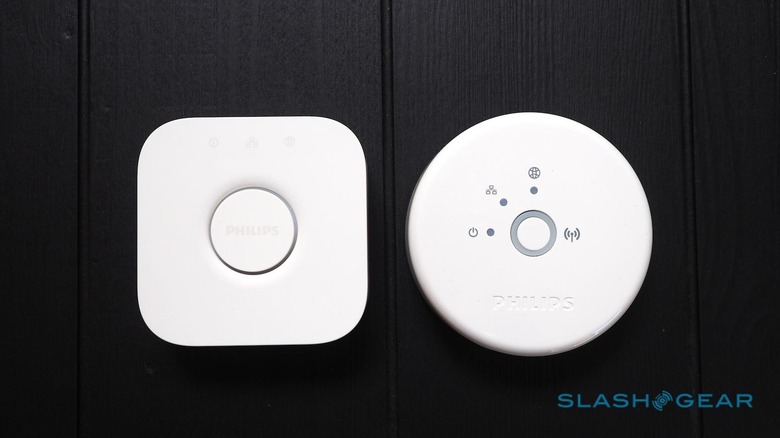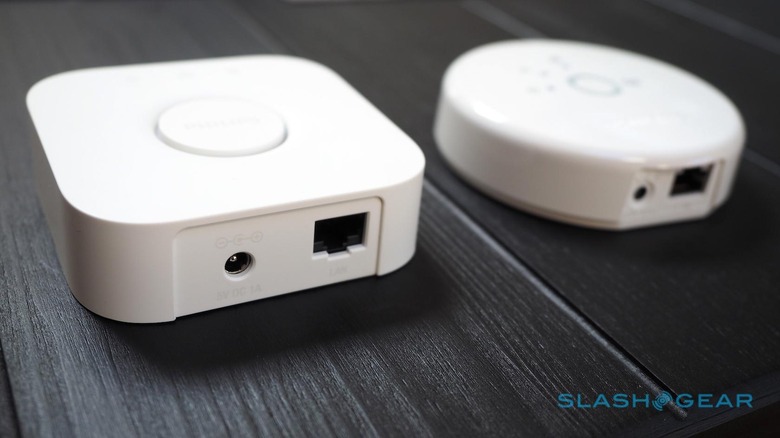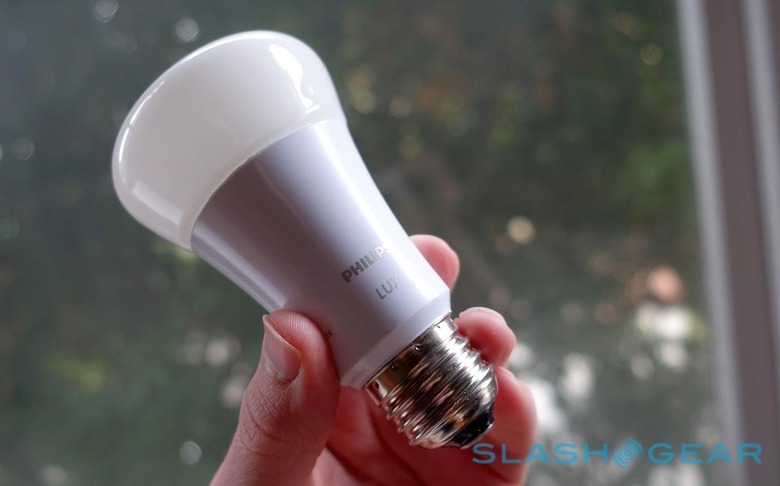The Philips Hue V1 Bridge Is About To Lose Support And Owners Are Furious
Philips has begun notifying users of its first-generation Hue bridge that it's time for an upgrade, after warning owners that it would be discontinuing support and new features for the smart lighting hub. Users of the Hue Bridge V1 started receiving alerts in the app this week that their cloud support was nearing the end, and the reception hasn't been entirely positive.
Among the first of the connected lighting platforms, Hue bulbs rely on a base station connected to a home router for their full functionality. The circular V1 bridge was superseded by the square V2 bridge in late 2015, bringing with it more processing power, compatibility with platforms like Apple's HomeKit, and voice support with services like Amazon Alexa and the Google Assistant.

For several years the two bridges co-existed, but Signify – the owner of Philips Hue – announced last year that it would be ending support for the V1 model. In April 2019, it warned that after April 30, 2020 there would be no new software updates for the first-generation, circular bridge. It would also no longer have compatibility with the Hue cloud services.
Cut off from the cloud, but the lights are still on
That cessation of cloud services meant that users of the original Bridge would not be able to remotely control their lighting while away from their home network. It also could impact some third-party lighting integrations, which rely on that cloud interface in order to control the wireless-enabled Hue bulbs.
That's not to say the lights are going off permanently. There's already a Philips Hue Bridge V1 app, which allows for local control over the lights. In order for it to work, the smartphone it's installed on must be on the same network as the V1 bridge itself.
While that may be sufficient for some owners, Signify warns that as well as no feature upgrades they'll also be missing out on future security patches.

"Although the Hue Bridge v1 may continue to function with older versions of our applications and/or third-party software after this date we recommend that you upgrade to a new version of the Hue Bridge," the company states. "Signify will no longer issue security updates and your v1 Bridge may no longer be secure. We do not recommend use of Hue Bridge v1 after April 30, 2020 due to potential security concerns."
That's not just a theoretical issue, either. As we saw in February 2020, Hue bulbs can be just as vulnerable to hacks as other Internet of Things (IoT) devices. Signify patched that problem – and indeed one of the advantages of the V2 bridge is that it can automatically install security firmware rather than relying on users to do so manually – but after April 20 of this year there'll be no version for owners of the original bridge.
Old news, new notification
Signify probably thought it had given Hue users a good amount of notice of the transition. Back when the V2 bridge launched in 2015, it offered an upgrade discount that shaved a third off the $60 bridge for existing owners. With the arrival of a notification in the Hue app warning of the imminent end-of-support status of the V1 bridge, though, it's finding out that for some customers this is coming as a surprise.
They're emerging on Twitter to complain about their hardware, both with frustrations at feeling pressured to upgrade, and concerns that Signify does not have a recycling program in place for the V1 bridge.

Signify isn't the first company to discover existing users can find this sort of transition unwelcome – and be vocal about it. Back in late 2017, Logitech notified Harmony Link owners that their universal remote system would be bricked, and offered them a discount on upgrading from the then-six-year-old product. Owner outcry followed, and Logitech was forced to backtrack and offer every existing owner a free Harmony Hub, the successor to the discontinued product.
Just what does "future proof" mean?
One of the concerns Signify is facing from users is just how long the Hue Bridge V2 can be expected to ask. After all, it has been on the market for more than four years now. The company says that it's been designed to be "future proof," and that we shouldn't expect a replacement any time soon.
"There is currently no scheduled end of life for the V2 bridge," Signify told one concerned user, "and we're not working on a new bridge at the moment either so will continue working with the V2."
As for what to do with the old V1 bridge, Signify doesn't have a program of its own to dispose of the hardware. "We encourage our customers to recycle the product if upgraded," it told another user, "we recommend them to reach out to their local separate collection system for electrical and electronic products."

Recycling for aging IoT devices is a topical subject right now. Sonos made the decision late in 2019 to offer a recycling program for its older connected speaker hardware, which involved permanently bricking the devices before their owners were considered eligible for a discount on new hardware. Uproar followed, and this week Sonos announced it would no longer be demanding the products be disabled.
It leaves, however, the question of just how much support – and for how long – IoT device owners should reasonably be able to expect. Signify, Sonos, and Logitech all had the same justification for the decision to cut ties with their aging hardware: it was simply too old to support the current features that users expect. Relentless progress is an inevitability of the consumer tech industry, but while we may be resigned to upgrading our laptops and phones every few years, if not sooner, the thought of doing the same with IoT infrastructure is far tougher to swallow.
